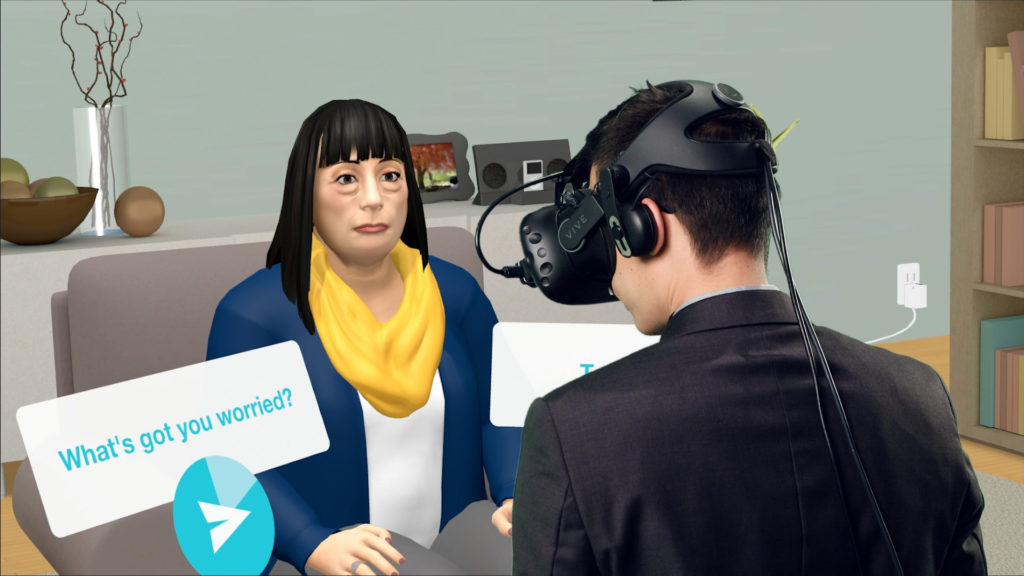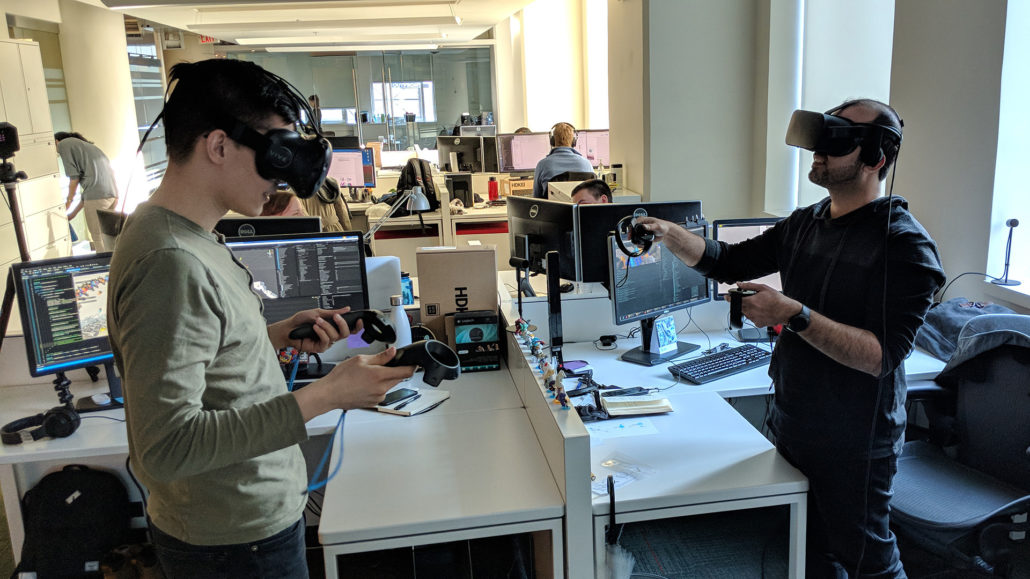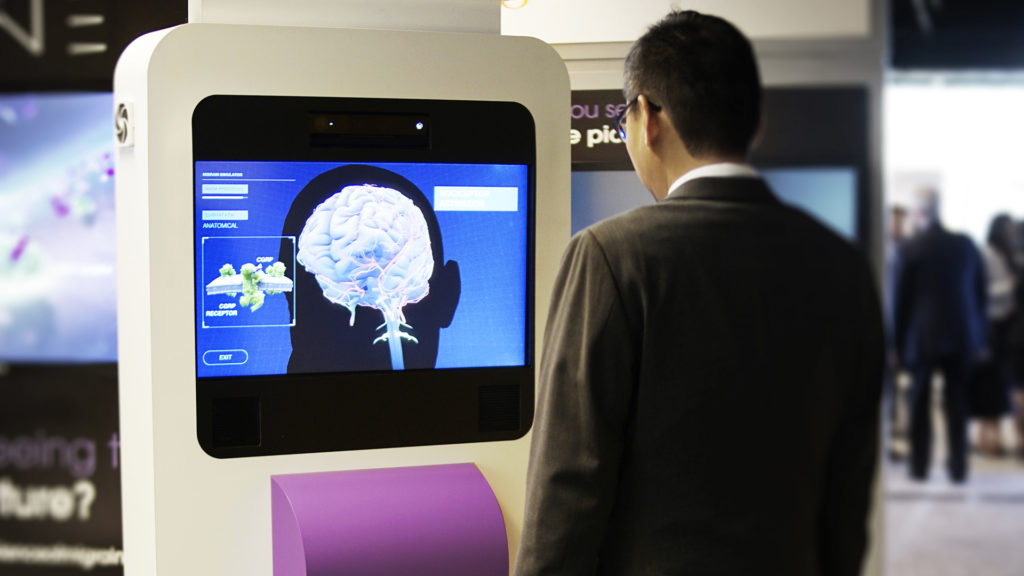
Medical Virtual Reality (VR)
VR provides an unparalleled immersive experience for medical training and pharmaceutical education and marketing. With today’s advanced VR systems, we bring stunning, high-resolution 3D graphics to a wide range of topics, from disease awareness to surgical procedures. Medical VR can be delivered via portable devices, at conference booths and at home to support CME and marketing initiatives. The possibilities for VR in medical education, training and marketing are limited only by the imagination.

It’s been an absolute pleasure working with AXS. They overhauled our scientific materials, providing a consistent look across all our tangible and digital assets to convey our scientific pipeline in a graphically appealing way.
Heather Douangpanya
Director, Global Scientific Communications, Seagen Inc.

Everything from the animation and the stills visually show the story of FaraPulse and the market leading product we set out to achieve. The final deliverables met and even exceeded the original vision. KUDOS and THANKS to you and the team on an AMAZING end product.
Dan Chase
Principal Product Manager, Boston Scientific

We chose AXS Studio because of their unique ability to curate a better, more visually impactful story resonating with both a scientific and non-scientific target audience.
Glen Tinevez
Vice President, Marketing North America Commercial Operations,
Ortho Clinical Diagnostics
Ortho Clinical Diagnostics

The AXS team was a pleasure to work with and I greatly appreciated their creative and scientific expertise. The videos received outstanding feedback and are one of the most popular assets for our disease state education campaign.
Rachel Raynes
Global Medical Communications, Senior Manager | Heart Failure GCCL, AMGEN

What a privilege and blessing it has been working with the AXS team these last few months. The incredible quality and attention to detail in your work, the care you put into navigating relationships, and the commitment you have to pulling off the impossible — it’s been a sight to behold. We are so grateful and appreciative of all your efforts. Thank you!
Susan Bartlett
Principal, Workomics

You guys are doing great work! The animation with the electric field displayed has been an 'AH-HA' moment for all of our Doctors, strategic collaborators and many of our employees!
Allan Zingeler
President & CEO, Farapulse

My previous vendor struggled to conceptually understand the purpose of the project. AXS understood and delivered an amazing product—better than what I initially imagined. We have experienced more engagement with key customers and investors, and the interactive will be a tool we can use across multiple platforms.
Julie Whitcomb
Head of Medical Affairs, Eyenovia

Wow! Just wow! 🤯 mind blown! This is amazing!! My heartfelt gratitude to your team. Their dedication to our project is only outweighed by their creative talents.
John West
Chief Development Officer, SciMar Ltd.

AXS was a true partner in creating highly compelling MOA videos for an important pharma client. They collaborated with us through numerous challenges on a tight schedule and hit our deadline with a product our client loved!
Senior Account Executive, Goodfuse

Thank you for being so great to work with and for creating such an amazing animation. Everyone loves it. Our Director of Sales called it “a game changer”. Our CEO presented the animation in recent talks and shared it with retina specialists. It is a hit! AXS has been a valuable partner and we look forward to working with you again in the future.
Allison Dabney
Director, Marketing, LumiThera

I can always rely on AXS to bring me unique, creative ideas for interactive media that boost traffic and HCP engagement at our congress booths.
Peter Baumeister
Senior Manager, Global Scientific Communications,
Amgen
Amgen

It’s been wonderful working with AXS Studio. The experience has been fantastic, fun, and rewarding. We have had glowing feedback on the video and are finalizing plans to integrate into discussions with all prospective research candidates. Our patient character is crushing it in the Alzheimer’s LP world.
Danielle Goldfarb
MD, Clinical Assistant Professor of Neurology and Psychiatry, Banner Sun Health Research Institute

These are absolutely fantastic visualizations. They convey the real science. I still am incredibly proud of what we did together on this video and I use it in my lectures to Harvard students and externally.
Donald E. Ingber
MD, PhD, Director, Wyss Institute for Biologically Inspired Engineering, Harvard University

The team at AXS are true pros. They asked all of the right questions from the start, from technical/scientific details to overall look and feel, and completed this amazing cover rather quickly as a result.
Kelly Krause
Creative Director, Nature

It is an absolute pleasure to work with the AXS team. Their work is consistently well-researched, beautifully crafted, and press-ready.
Jen Christiansen
Art Director of Information Graphics, Scientific American Magazine

Collaborating with the AXS team on high-impact science visualization projects is always a pleasure. I can rest assured that the final product will be clear, elegant, and beautiful while meeting our target audience’s needs.
Fabian de Kok-Mercado
Creative Director, Howard Hughes Medical Institute (HHMI)

Your clear, didactic visuals enabled us to open a vital dialogue with physicians, drawing their attention to a rare genetic disorder, its causes, diagnosis, and treatment.
Joel Bathe
Senior Product Manager,
Genzyme Canada
Genzyme Canada

The AXS team works hard to understand our needs and goals to best interpret them to create a product that consistently exceeds our expectations. I’ve hired AXS in the past and will always look for a way to hire them in the future.
Adam B. King
Global Branding and Marketing Communications Manager,
Heartware
Heartware

AXS Studio is one of the top multimedia companies in our industry. Partnering with them on a booth activity is different; they’re always thinking ahead and thinking proactively.
David Clark
Vice President,
D&J Electronics
D&J Electronics

The Ad Board meeting went very well and the feedback on the animated piece was outstanding, even from the biggest and most important critics—who said they had never seen anything that was so well done and presented the topic so perfectly! Thanks again for helping to make this vision a reality for us and for all of the effort that you put forth on this project.
Vicki Kelemen
Senior Director of Market Development, Amylin Pharmaceuticals
Who we've proudly worked with
Where our work has been featured
We support clients across all therapeutic areas. Science inspires us and we want to share it with others
Let’s work together
to tell your story.
Why invest in medical virtual reality?
- VR takes your medical or pharmaceutical training to the next level, giving your audience an exciting and memorable learning experience.
- VR attracts more visitors to pharma conference booths. These 3D immersive experiences are proven to increase booth foot traffic and engagement.
- To give your medical or surgical trainees a 3D immersive experience. Medical VR makes content more engaging and memorable.
- With medical VR , you can demonstrate your medical device features and benefits anywhere, including conference booths and hospitals.
- Medical and pharma VR activities leverage active learning for your users. Active participation using VR technology enhances engagement with your content and improves information retention.
- Once you create a pharma or medical virtual reality app, we can deploy it to any number of VR headsets anywhere you interact with customers.
- Virtual reality is a lasting investment. We future proof your medical VR experience for periodic updates and a long product lifecycle.
The AXS Studio difference
Our designers and developers care a lot about the user experience when creating medical science VR experiences. We take a user-centered design approach throughout the development process, rigorously testing each experience for ease of use, learning effectiveness, and performance. Helping our healthcare and pharma clients change lives inspires us to deliver the very best virtual reality experiences possible.

Early VR adopters
AXS Studio was one of the first medical animation companies to use virtual reality in the pharmaceutical industry. Our development team was experimenting with VR headsets long before they showed up in scientific meeting exhibit halls. We aim to continuously push boundaries in pharma and healthcare VR to deliver many firsts for our clients.
Unique ideas
Virtual reality makes it possible to connect healthcare providers with your messaging in truly original ways. For example, they can converse face to face with a virtual patient to learn what life is like with chronic kidney disease or journey deep into the brain in a migraine VR experience. We tap into our collective creativity via design thinking to discover unexpected ideas for your next medical VR activity.
The right team
Creating the best medical VR experiences requires an unequaled team: multidisciplinary, highly creative and science literate. With postgraduate training in scientific communications, certification, and more than 20 years serving clients in pharma and healthcare, we’re unlike any sci-comm company you’ve worked with. Meet our team.
We speak your language
Our Client Services team members come from life science backgrounds, so they speak your language. They understand the challenges you face, from satisfying cross-functional stakeholders to navigating MLR reviews, and will make the process of creating a medical VR experience straightforward and rewarding.
VR down to a science
Because all medical VR design and production work is done in-house at AXS Studio—concept art, script writing, UX and UI design, 3D animation, programming and testing—we carefully control the entire production process, ensuring flawless performance and on-time delivery.
Prepared for success
At AXS Studio, we carefully reference and prepare all pharma VR review materials to our clients’ MLR/PRC submission specs. We ensure your scientific content—spoken, written and visual—will stand up to scrutiny by your medical and regulatory reviewers, keeping your VR project on time and on budget.
Frequently Asked Questions
Most sci-comm and healthcare agencies outsource virtual reality projects to non-medical interactive studios. At AXS, all design and development is done in-house by our specialized team, ensuring a higher level of quality control and shorter timelines.
On top of this, AXS Studio medical artists hold M.Sc. degrees in biomedical communications from one of only five graduate programs accredited by CAAHEP. These specialized programs train designers, animators and developers in gross-human anatomy, cell and molecular biology, physiology and pathology. The other medical VR companies pair non-science artists with PhD or PharmD content writers, an approach that may result in no one on the team knowing what the science looks like, meaning their work may not hold up to scrutiny by experts—your audience.
AXS Studio has over 20 years experience visualizing medical science for science-literate audiences. We employ five Board-Certified Medical Illustrators (CMIs) who ensure accuracy in every medical VR experience we create. We speak the language of science and communicate complex concepts more accurately and clearly than other agencies that lack this specialized science training.
Simply contact us with a project description that includes the audience/user, timeline, budget and objectives for your medical or pharma VR application. We’ll schedule a consultation to discuss the project goals and scope, then send you an itemized proposal for review.
The main determinants of cost are the complexity and functional requirements of your VR experience. We will account for your budget when proposing a VR solution. Our fees include:
- Content writing
- UX design
- Visual asset creation
- 2D and 3D animation
- VR programming
- VR hardware (optional)
- Testing, deployment and support (on-site or remote)
We handle all content development, visual, and interactive programming in-house. This enables us to carefully manage development costs and maintain confidentiality for our clients. If you’d like to get a quote for a medical VR experience, please get in touch.
Our fees include concept ideation, content research and writing, UX and UI design, wireframing, 3D modeling and animation, programming, audio (voiceover, music and sound effects), usability and performance testing, client support and training. During VR application development, we prepare wireframes and videos for your MLR (or PRC) reviews and will handle the submission of review materials, if desired.
At AXS Studio, we’re committed to communicating your science accurately. Our fees include content research and the preparation of a comprehensive research deck to support the creation of all the visuals featured in your medical VR application.
Clients frequently express relief after switching from their previous agency, citing challenges, including:
- Unexpected overages to fix errors made by their agency
- Vendors who struggled to understand the purpose of their project
- Surprise technical issues during setup at their congress booth
- Stressful last-minute deliveries
In contrast, clients have described AXS Studio as “a talented and reliable partner”, and noted ”the commitment [we] have to pulling off the impossible” and the “incredible quality and attention to detail in [our] work“. Our clients express relief at no longer being concerned about hitting deadlines. We collaborate well with their other vendors, who appreciate that AXS Studio is “always thinking ahead and thinking proactively.”
When it comes to pharma VR applications, leading pharmaceutical companies trust AXS Studio to deliver unique solutions “that boost traffic and HCP engagement at … congress booths.” But don’t just take our word, read what our clients have to say.
Concept to completion can take three to five months, depending on the scope of your VR project. If you’re targeting a launch date, it is important to begin early—especially if your company’s MLR/PRC process is quite involved. It is our recommendation to get in touch for a quote six months before your due date. We’ll send you a detailed proposal, including a timeline with project milestones for your team.
Five minutes or shorter is a good target if your VR project is for a congress booth. HCPs at a scientific meeting are usually busy and have limited time to spend with your content. Being concise with focused messaging gives booth visitors the highest value for investing their time; we advise prioritizing three main messages for a pharma VR activity. Virtual reality for medical training can be as long as needed to cover the essential training material, although we recommend periodic breaks if your VR experience exceeds 10 minutes.
- Start by clearly defining your primary audience (or user) and communication objectives. Your audience will inform the language and tone used. Are you speaking to specialists, general practitioners, or patients?
- Send us your key content resources and reference materials, including scientific posters, MSL decks, and journal papers.
- Our design and development teams will ideate to generate an original user journey for your medical or pharma VR experience. We’ll present this to you as an outline with concept sketches. This step may go through a couple of iterations.
- Next, we’ll create a wireframe that details the proposed user experience, content and visuals. A wireframe is like a storyboard for an interactive application that clearly shows how your medical VR experience will look and function. The wireframe is essential for getting all stakeholders aligned before application development begins. After a round of review, we’ll make any necessary revisions and resubmit the wireframe for your team’s MLR (or PRC) review.
- Once the wireframe is approved, our team will develop the alpha, beta and final versions of your medical VR experience. We will submit the beta version for MLR/PRC review and incorporate any revisions into the final VR application.
- During development, we will pre-test the VR application with your booth vendor or app deployment team to ensure it works flawlessly when launched.
- Following MLR/PRC approval, we will coordinate with your booth vendor training team to deploy the finished medical VR experience to your congress booth or internal devices.
Scientific communications and Medical affairs managers at biopharmaceutical companies commission VR experiences to educate HCPs on mechanisms of disease and drug mechanism of action at conference booths. Interactive VR provides visitors a more engaging and interesting experience than video and interactive activities on regular monitors.
Marketing managers and product managers for medical device companies commission VR experiences to demonstrate medical product features and benefits at congress booths.
Surgical training companies commission VR applications to train surgeons on new technologies and procedures.
We will design your medical VR application for easy use by your booth visitors. Visual and audio instructions will guide users through every step. Having a facilitator is great to get people started with the experience: inviting them to try it out and helping them put on the VR headset. We’re happy to recommend a facilitation vendor that our clients have had great experiences with in the past.
AXS Studio designs the kiosks and works with our clients’ booth vendors, who manufacture the finished structures. We also coordinate with our clients’ audio-visual suppliers to provide VR headsets or other supporting equipment needed for the exhibit. For example, we often mirror the VR experience or show a trailer on a large monitor to act as a booth draw.
Game controllers can be used and the VR application can be designed for simple operation by participants who are new to VR and games. AXS Studio also creates hands-free interactive VR experiences where participants can navigate via head movement and hand gestures.





